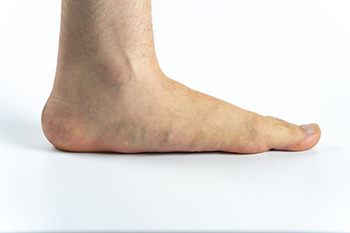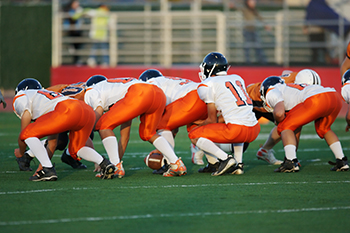Items filtered by date: March 2023
Overpronation From Flat Feet

Overpronation is when the arch of the foot collapses and the foot and ankle roll inward when walking. Medically, this is called pes planus, flexible flatfoot, or more commonly, flat feet. Those who overpronate can be at risk for more injuries than others. Children are born with flat feet, but arches typically develop in the teenage years. Overpronation can occur when the arches are overly flexible, and it can be caused by obesity or pregnancy, inflammation or damage to the tendon, or arthritis in the foot, among other things. Walking or standing can be uncomfortable for those who overpronate. Relief can be found by wearing more supportive shoes, using orthotics, and maintaining a normal body weight. If you have ongoing foot pain, it is suggested that you make an appointment with a podiatrist for a proper diagnosis and treatment plan.
Flatfoot is a condition many people suffer from. If you have flat feet, contact Dr. John Branwell from Kearny, New Jersey. Our doctor will treat your foot and ankle needs.
What Are Flat Feet?
Flatfoot is a condition in which the arch of the foot is depressed and the sole of the foot is almost completely in contact with the ground. About 20-30% of the population generally has flat feet because their arches never formed during growth.
Conditions & Problems:
Having flat feet makes it difficult to run or walk because of the stress placed on the ankles.
Alignment – The general alignment of your legs can be disrupted, because the ankles move inward which can cause major discomfort.
Knees – If you have complications with your knees, flat feet can be a contributor to arthritis in that area.
Symptoms
- Pain around the heel or arch area
- Trouble standing on the tip toe
- Swelling around the inside of the ankle
- Flat look to one or both feet
- Having your shoes feel uneven when worn
Treatment
If you are experiencing pain and stress on the foot you may weaken the posterior tibial tendon, which runs around the inside of the ankle.
If you have any questions please feel free to contact our office located in Kearny, NJ . We offer the newest diagnostic and treatment technologies for all your foot and ankle needs.
Common Foot Injuries Among Athletes

The four most common foot injuries reported by runners and athletes are stress fractures, plantar fasciitis, turf toe, and bunions. Plantar fasciitis is caused by microtears and inflammation in the band of tissue, called the plantar fascia, that runs beneath the foot. Stress fractures are tiny, hairline cracks in the bones of the feet, mainly the metatarsals, often a result of overtraining. Because the fractures are so small, detecting them may be difficult. An MRI or a bone scan may be necessary to see them. Turf toe is caused by overextending the joint of the big toe, common to athletes who repeatedly push off from the big toe. This may include football players, dancers, and gymnasts, among others. Bunions, which are largely thought to be genetic in nature, can be further aggravated by wearing improperly fitting shoes. Any of these types of foot pain can increase if a person is overweight, overtrains, or wears improper shoes for their activity. For more information on dealing with foot pain, it is suggested that you consult with a podiatrist for treatment options.
Sports related foot and ankle injuries require proper treatment before players can go back to their regular routines. For more information, contact Dr. John Branwell of Kearny, New Jersey. Our doctor can provide the care you need to keep you pain-free and on your feet.
Sports Related Foot and Ankle Injuries
Foot and ankle injuries are a common occurrence when it comes to athletes of any sport. While many athletes dismiss the initial aches and pains, the truth is that ignoring potential foot and ankle injuries can lead to serious problems. As athletes continue to place pressure and strain the area further, a mild injury can turn into something as serious as a rupture and may lead to a permanent disability. There are many factors that contribute to sports related foot and ankle injuries, which include failure to warm up properly, not providing support or wearing bad footwear. Common injuries and conditions athletes face, including:
- Plantar Fasciitis
- Plantar Fasciosis
- Achilles Tendinitis
- Achilles Tendon Rupture
- Ankle Sprains
Sports related injuries are commonly treated using the RICE method. This includes rest, applying ice to the injured area, compression and elevating the ankle. More serious sprains and injuries may require surgery, which could include arthroscopic and reconstructive surgery. Rehabilitation and therapy may also be required in order to get any recovering athlete to become fully functional again. Any unusual aches and pains an athlete sustains must be evaluated by a licensed, reputable medical professional.
If you have any questions please feel free to contact our office located in Kearny, NJ . We offer the newest diagnostic and treatment technologies for all your foot and ankle needs.
It's Time for Beautiful Feet
My 2nd Toe Hurts

The second toe might cause pain or discomfort if it is injured, or if one suffers from a chronic condition. One such condition is called capsulitis. This can cause irritation and inflammation at the base of the second toe. One might feel swelling in the toes, have trouble putting on or wearing shoes, and have pain at the ball of the foot that worsens when walking barefoot. It may feel like one is walking on a marble or that the sock is bunched up under the foot. Commonly, capsulitis results from improper foot mechanics, with the ball of the foot withstanding excess pressure. Metatarsalgia is another condition that causes pain in the ball of the foot that may be concentrated under the second toe. This often begins as a callus on the bottom of the foot, and it can put pressure on nerves and other structures around the toe. Another cause of second toe pain is an ingrown toenail. This is when the toenail is embedded into the skin of the toe. It can make the toe sensitive to the touch and sore. Since second toe pain can arise from different causes, it is suggested that you seek the counsel of a podiatrist who can help you identify the cause of your pain and offer treatment solutions.
Toe pain can disrupt your daily activities. If you have any concerns, contact Dr. John Branwell of Kearny, New Jersey. Our doctor can provide the care you need to keep you pain-free and on your feet.
What Causes Toe Pain?
Most severe toe pain is caused due to a sports injury, trauma from dropping something heavy on the toe, or bumping into something rigid. Other problems can develop over time for various reasons.
Toe pain can be caused by one or more ailments. The most common include:
- Trauma
- Sports injury
- Wearing shoes that are too tight
- Arthritis
- Gout
- Corns and calluses
- Hammertoe
- Bunions
- Blisters
- Ingrown toenails
- Sprains
- Fractures (broken bones)
- Dislocations
When to See a Podiatrist
- Severe pain
- Persistent pain that lasts more than a week
- Signs of infection
- Continued swelling
- Pain that prevents walking
Diagnosis
In many cases the cause of toe pain is obvious, but in others, a podiatrist may want to use more advanced methods to determine the problem. These can range from simple visual inspections and sensation tests to X-rays and MRI scans. Prior medical history, family medical history, and any recent physical traumatic events will all be taken into consideration for a proper diagnosis.
Treatment
Treatments for toe pain and injuries vary and may include shoe inserts, padding, taping, medicines, injections, and in some cases, surgery. If you believe that you have broken a toe, please see a podiatrist as soon as possible.
If you have any questions please feel free to contact our office located in Kearny, NJ . We offer the newest diagnostic tools and technology to treat your foot and ankle needs.
Effective Stretches for Hammertoe

People who have the foot condition that is known as hammertoe will notice their toes are rigid. Hammertoe can happen from genetic reasons or from wearing shoes that do not have ample room in the toe area. This can cause the toes to shift together, and the pressure can make the second and third toes bend downward at the middle joint. It is sometimes painful while wearing shoes, and corns and calluses may form on the bent joint as it touches the top of the shoe. Stretches can be performed which may help to increase the toe's flexibility. A toe crunch is done while sitting in a chair, and placing a towel under your feet. The toes can be stretched by gripping the towel continually as you make your way to the end of it. An effective stretch can be done with a towel, as it is wrapped around the toes and pulled gently toward you. After holding for several seconds, this can be repeated. If you have developed hammertoe, it is suggested that you consult with a podiatrist who can help you to manage this condition.
Hammertoe
Hammertoes can be a painful condition to live with. For more information, contact Dr. John Branwell from Kearny, New Jersey. Our doctor will answer any of your foot- and ankle-related questions.
Hammertoe is a foot deformity that affects the joints of the second, third, fourth, or fifth toes of your feet. It is a painful foot condition in which these toes curl and arch up, which can often lead to pain when wearing footwear.
Symptoms
- Pain in the affected toes
- Development of corns or calluses due to friction
- Inflammation
- Redness
- Contracture of the toes
Causes
Genetics – People who are genetically predisposed to hammertoe are often more susceptible
Arthritis – Because arthritis affects the joints in your toes, further deformities stemming from arthritis can occur
Trauma – Direct trauma to the toes could potentially lead to hammertoe
Ill-fitting shoes – Undue pressure on the front of the toes from ill-fitting shoes can potentially lead to the development of hammertoe
Treatment
Orthotics – Custom made inserts can be used to help relieve pressure placed on the toes and therefore relieve some of the pain associated with it
Medications – Oral medications such as anti-inflammatories or NSAIDs could be used to treat the pain and inflammation hammertoes causes. Injections of corticosteroids are also sometimes used
Surgery – In more severe cases where the hammertoes have become more rigid, foot surgery is a potential option
If you have any questions please contact our office located in Kearny, NJ . We offer the newest diagnostic and treatment technologies for all your foot and ankle needs.

